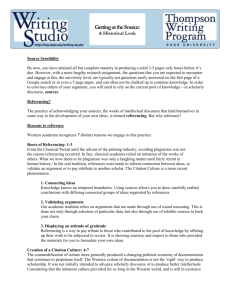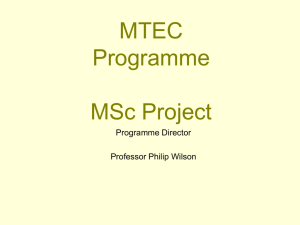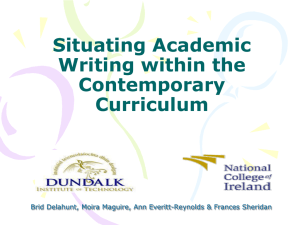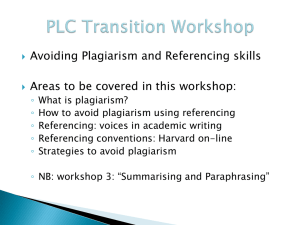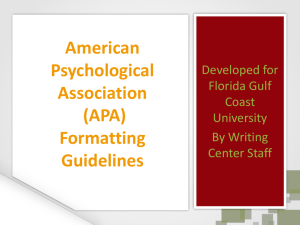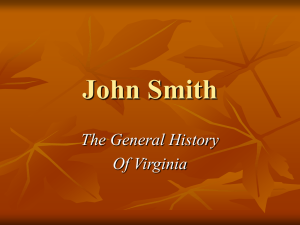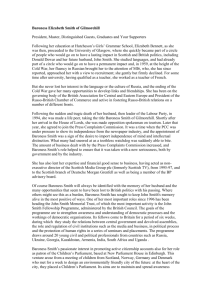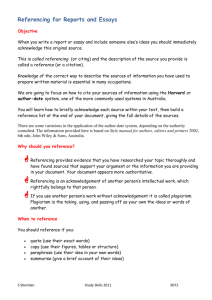Why/when reference? - Glasgow Caledonian University
advertisement
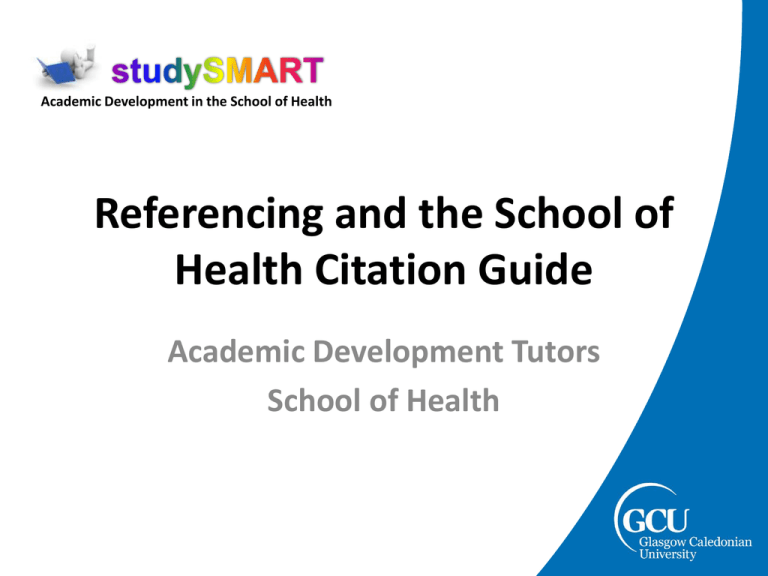
Academic Development in the School of Health Referencing and the School of Health Citation Guide Academic Development Tutors School of Health Today’s session • Overview of when and why we need to reference • Guidelines for referencing on your programme • Tips on introducing references into the text • Paraphrasing and avoiding plagiarism Why/when reference? • Why do you have to reference? – To provide evidence to support ideas that you draw upon in your writing – To credit another writer – To allow reader to follow-up the reference • When should you reference? – When draw upon idea that is not your own, e.g. • Point of view/argument • Statistical information • Published evidence • Without references ideas lack credibility, e.g. – Some health professionals burn out due to the emotional strain of the job • Compare this with: – Steele (2010) explains that due to the clientcentred nature of healthcare, service providers might become emotionally drained Typical sources of references • • • • • Main sources are: Books Journal articles Electronic databases What about the internet? • May not be reliable, look for author name, contact details, date of publication. If unsure, see: • http://www.vts.intute.ac.uk/detective/ brief.html School Citation Guidelines • There are different systems for referencing • School uses the Harvard system of referencing • Always follow the School guidelines; don’t follow other guidelines (e.g. others found on internet) • Don’t try to learn it; sit it in front of you when writing Where should the references go? In the United States it is estimated that 75-85% of people with severe mental illness are unemployed, whereas estimates in the United Kingdom range from 61% to 73%.Yet despite these high unemployment rates, surveys consistently show that most people with severe mental illness want to work. There are compelling social, and clinical reasons for helping people with mental illness to work. From a social standpoint, high unemployment rates are an index of the social exclusion of people with mental illness, which the US and UK governments, among others, are committed to reducing. From a clinical standpoint, employment may lead to improvements in outcome through increasing self esteem, alleviating psychiatric symptoms, and reducing dependency. Referencing components • There are 2 components to a reference: 1. In text reference (e.g. Smith, 2010) 2. Full reference details (at the back) – e.g. Scottish Executive. 2000, Allied Health Profession now and into the future. HMSO, Edinburgh. Text citations (see section 2.0 of Citation Guide) • Give the author(s) surname and publication year in the text of your work and the full reference at the back. • 1 author: surname and date (Anderson, 2005) • 2 authors: surnames and date (Anderson & Smith, 2005) • If no brackets use ‘and’ rather than ‘&’ e.g: Anderson and Smith (2005) reported that…. Text citations (see section 2.0 of Citation Guide) • If more than 2 authors use ‘et al’ e.g: (Anderson et al, 2005) • If quote word for word, need to give the page no. e.g: • McArdle, Katch and Katch (2001, p.376) state that; “slow twitch fibres generate energy for ATP resynthesis predominantly through the aerobic system of energy transfer.” A few things to remember... • If no name on website article, cite the organisation, e.g. (Scottish Government, 2009) • Don’t quote big sections unless can’t put in own words – why? • Looks like don’t understand what author is saying • Text looks ‘bitty’ and badly structured Weaving references into the text Some examples: • As Smith (2004) argued…. • Smith and Bloggs (2001) suggested that…. • One researcher (Smith, 2005) argued that…. • Other authors have agreed with this view (Anderson & Bloggs, 2003; Smith, 2005) • Smith (2007) supports this, stating that…. • Further studies have shown that….(Anderson & Baker, 2002; Smith & Bloggs, 2008) • Multiple sources should be listed in chronological order and separated by semi-colons Useful words for reporting • Examples of verbs you can use to report the views of others: • Allege, assert, claim, consider, contend, declare, demonstrate, explain, found, report, show, state, suggest, surmise, warn • NB: Consider carefully what words you use – some words have stronger implications than others Plagiarism • What is plagiarism? – The unacknowledged use of another’s work as if it were your own) • Much of plagiarism at university is not deliberate cheating; it tends to be a failure to reference and quote properly. • Considered a very serious offence • Turnitin – don’t be tempted! • Easy to accidentally plagiarise Avoiding plagiarism - paraphrasing • Make sure you paraphrase (put author’s ideas in your own words), e.g. • Original: In the first year of life, infants form an attachment – a deep, affectionate, close and enduring relationship – with parents (Bowlby, 1973). • Paraphrased: The strong bonds or ‘attachments’ that infants develop with their parents in the first year of life can be considered to be deep and durable (Bowlby, 1973). • NB: Be very careful not to change the meaning of the original text Be confident – put the text in your own words • Original: First impressions are difficult to change and typically have a long-lasting influence on how one person reacts to another (Clarke, 2003) • Paraphrased: According to Clarke (2003), once first impressions are formed, they cannot be altered easily and often have an enduring effect on how individuals interact with each other. Reference list (see section 3.0 of Guide) • Positioned at back of essay (books will often also have a reference list at the back) • Reference list contains ALL details of the sources you have used • Follow the Citation Guide very carefully • References should be presented in alphabetical order Constructing a reference list: the rules • Book: Smith, P. 2005, Living in Glasgow, 3rd edn, Longman, Edinburgh. • Chapter in a book (where chapters are written by different authors – section 3.2 of Guide): Ferguson, D. 2008, “Rehabilitation.” in: Occupational Health Nursing, ed. K. Oakley, 2nd edn, Wiley, Chichester, pp. 253-270. • Journal article: Shrewsbury, M. 2003, “Pollical oblique ligament in humans and non human primates”, Journal of Anatomy, vol. 202, no. 4, pp.51. Referencing electronic material • See section 4.0 of guide • Web page (section 4.1 of Guide): Daly, J. & MyiLibrary, 2005, Professional nursing: concepts, issues, and challenges [online]. Springer, New York, NY. Available at: http://www.myilibrary.com?id=181155&Ref=Athens [Accessed 26th March 2010]. • If no author is identified, e.g: Library Services: Glasgow Caledonian University. 2010, [online]. Available at: http://www.gcal.ac.uk/library/ [Accessed 31st August 2010]. Reference list (continued) • List all authors but if more than 6, use ‘et al’ after the 6th author • If more than 1 publication by same author, list by order of date (most recent first) • If more than 1 publication by same author in single year and used ‘a’ ‘b’ etc to distinguish them in the text. Use again in reference list, e.g. – Lazarus, R.S. 2000a, “How emotions influence performance in competitive sports”, The Sport Psychologist, vol. 14, pp. 229-252. – Lazarus, R.S. 2000b, “Toward better research on stress and coping”, American Psychologist, vol. 55, pp. 665-673. Other kinds of citations • Publication from corporate body - see section 3.6, e.g. • Scottish Executive. 2000, Allied Health Profession now and into the future. HMSO, Edinburgh. • Acts of Parliament – see section 3.11, e.g: • The Scottish Government, 2004, Higher Education Act, HMSO, Scotland, Edinburgh. Academic Development in the School of Health

